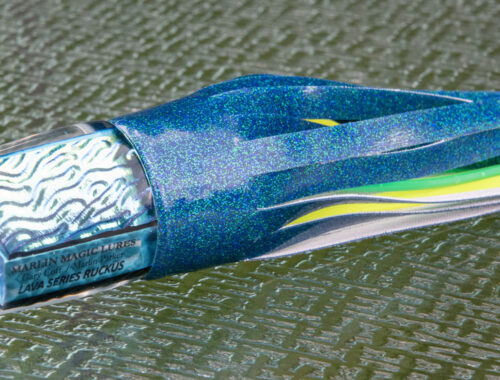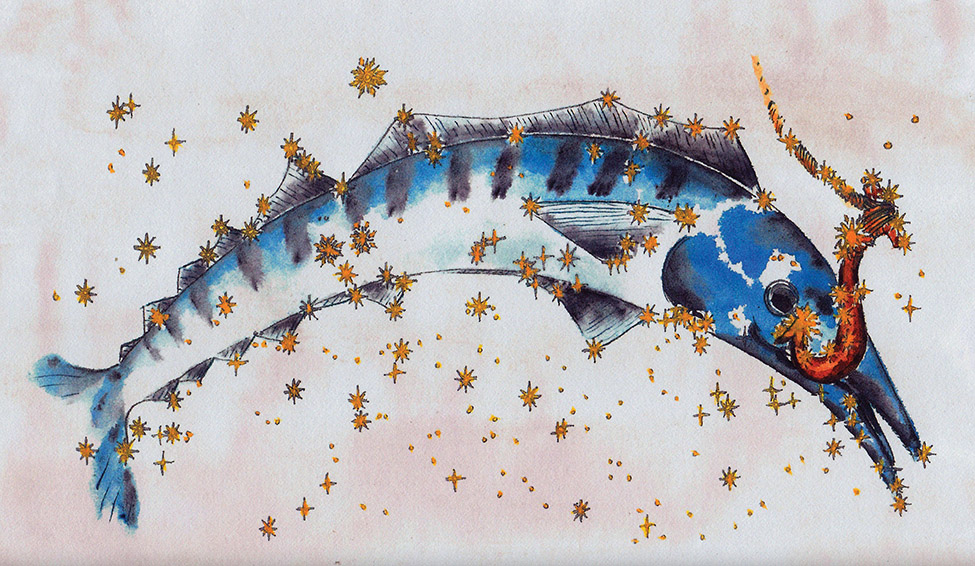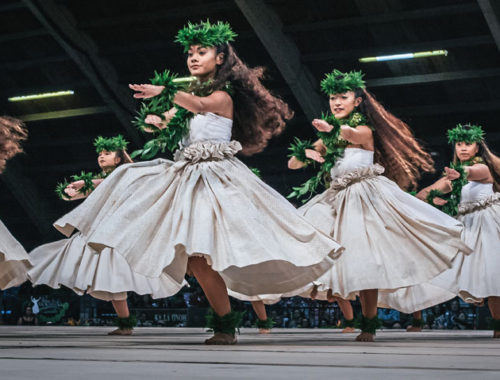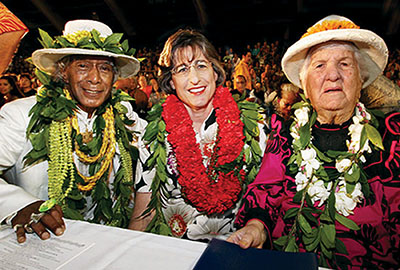
Then & Now: 50 Years of Merrie Monarch Festival–Nānā I Ke Kumu…Look to the Source
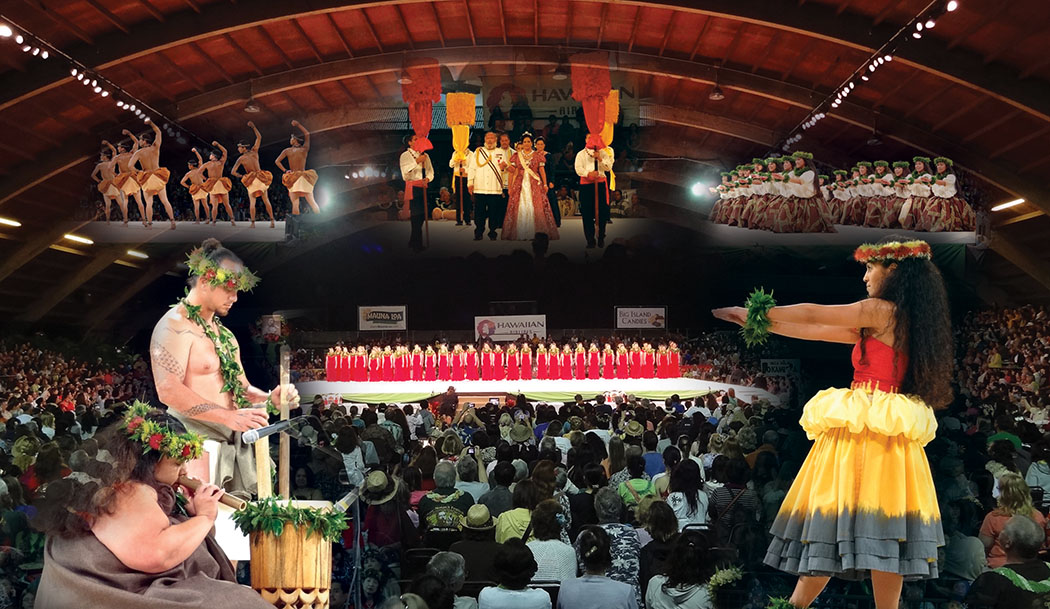 By Karen Valentine
By Karen Valentine
Something extraordinary happened in Hilo, Hawai‘i, in 1963—something no one would have guessed would blossom into the pinnacle of celebration and recognition of excellence in the Hawaiian cultural practice of hula. This year, the Merrie Monarch Festival is celebrating 50 years as a small-town festival that has achieved world wide fame.
The stacks of boxes of ticket requests are piled high in Luana Kawelu’s office. As president and executive director of the Merrie Monarch Festival, she has the responsibility to assign tickets for this year’s festival, held in the limited-seating venue of Edith Kanaka‘ole Tennis Stadium.
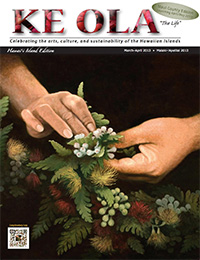
“It just breaks my heart to turn people down,” says Luana, daughter of the former executive director Dorothy “Aunty Dottie” Thompson, who passed the baton to her daughter upon her death in 2010 at age 88. “We have letters from countries all over the world from people who want to come: some from Europe, Japan, Taiwan, Australia, Tahiti, even Saudi Arabia.”
“I don’t think my mom ever knew it would be this big,” Luana says.
Today, throngs of people wait in line to get into the event, while dancers from two dozen hula hālau first honor the gods and goddesses of hula with ceremonies to prepare themselves for the final moments on a stage which thousands of feet have caressed in sacred dance, and where each spring, ipu heke (gourd drums) have echoed a heartbeat that goes back to the beginning of Hawaiian myth. The scent of flowers and maile is everywhere. Lights, cameras, and TV announcers are there to broadcast the event.
Looking back to the beginning: in 1960, the town of Hilo was devastated by a giant tidal wave, destroying many businesses. At the same time, the state’s main cash crop, sugar, was declining. Hawai‘i County Chairman Helene Hale called on her director of programs, George Na‘ope (“Uncle George”), one of Hawai‘i’s most famous and revered kumu hula and her administrative assistant, Gene Wilhelm, to come up with an idea to boost the economy. They thought of creating a festival honoring King David Kalākaua, known as Hawai‘i’s “Merrie Monarch,” because of his love of grand entertainment.
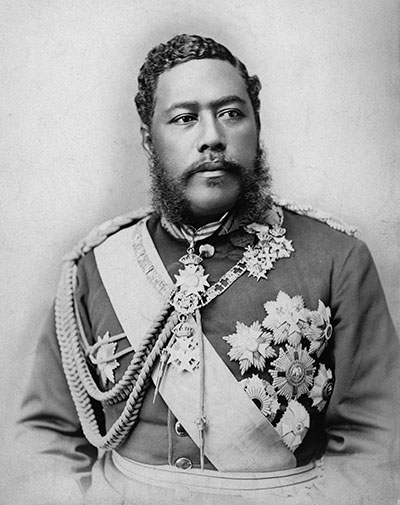
Together they devised every possible activity you could imagine to honor Kalākaua: a beard look-alike contest; a royal court complete with coronation; a torchlight parade; band concerts including the Navy Band; a “grogge shop” serving beer; a formal holokū ball; Hawaiian crafts; window displays; barbershop quartets; a massive bayfront hukilau (community fish netting); scavenger hunts, and a “mullet race,” a relay race in which live mullets were passed as batons! Master organizer, Aunty Dottie, who was a culture and arts specialist for the county’s Department of Parks and Recreation, helped put the plans into action.
In 1965 the County dropped its involvement, and the Hawai‘i Island Chamber of Commerce carried on, selecting a chairman every year. However, at the completion of the 5th annual Merrie Monarch Festival, it seemed doomed.
In a 2001 interview for the Honolulu Advertiser, Aunty Dottie is quoted as remembering, “[Chamber of Commerce officials] were going to kill it, for lack of a chairman, and the interest wasn’t there. I called the president of the chamber, Earl Hirotsu. I told him, ‘You can’t let another Hawaiian festival go down.’ … They had taken away the Kamehameha Day parade.” She paused. “He said, ‘Then chair it.’ ”
“I called everybody who was involved with the Merrie Monarch, and nobody would touch it with a 10-foot pole,” she said.
So she called his bluff and picked up the baton. Undaunted, the persistent Aunty Dottie again called on Uncle George, along with Haili Congregational Church choir director Albert Nahale‘a to help.
“I told George from the start, ‘We gotta make this Hawaiian. This isn’t Hawaiian at all.’ Why don’t we do what Kalākaua did by bringing together dancers from all the islands to the coronation?”
The group flew to Honolulu where Uncle George set up meetings with two kumu hula with large studios: Pauline Kekahuna and Louise Kaleiki. The pair proposed the idea of a hula competition and promised to bring their dancers.
And so, in 1971, the first competitive Merrie Monarch contest took place at the Hilo Civic Auditorium. Only nine groups were entered, and maybe 100 people came. And they made history.

The time was right and ripe, as a renaissance of Hawaiian culture was taking place. This new competition coincided with the building of the Hōkūle‘a and establishment of the Polynesian Voyaging Society. Hula had to be a part of it.
Uncle George commented in a 2006 interview when he was honored with a National Endowment for the Arts Lifetime Honors award, “I felt the hula was becoming too modern and that we have to preserve it. Kalākaua brought the hula back to Hawai‘i and made us realize how important it was for our people. I didn’t realize that it was going to turn out to be one of the biggest things in our state.”
Uncle George passed away in 2009 at age 81. His full name was George Lanakilakeikiahiali‘i Na‘ope, which meant, “the light that would lead the way” or “the protector of things of Hawai‘i.” With prescient wisdom, as often occurs in Hawaiian naming practices, his great-grandmother, Mary Maliapukaokalani Na‘ope, chose the name before he was born.
Kumu Hula Etua Lopes of Kailua-Kona, a student of Uncle George, and his hānai son, was recruited as a teenager to “volunteer” with the festival in 1971. Later he formed his own hālau, Hālau Hula Nā Pua U‘i O Hawai‘i, and entered students in the solo competition in 1976, 1978, 1983, and in group competition from 1993 to 2000. He will bring back his hālau to Hilo for the 50th Anniversary competition March 31-April 6.
“I’m very excited because I’m also celebrating 30 years in Kona,” he said. “My lineup dancing in Merrie Monarch stretches almost that whole 30 years. I look at them and lots of them are mothers now who danced in my keiki class years ago. I love my students.”
Kumu Etua’s hālau is also known for performing during the monthly Sunday afternoon event at Kona’s Hulihe‘e Palace.
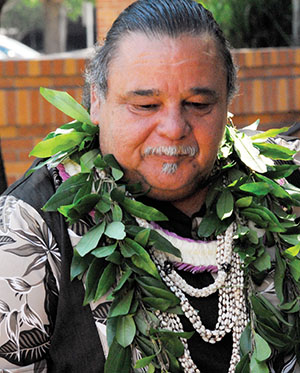
If Uncle George was like a father to Kumu Etua, Aunty Dottie was like a mother, he says.
“[The late Kumu Rae Fonseca and I] would go to her house and play Scrabble. In the beginning [of the festival] it was so hard. She sat in her office and hand wrote everything. She was the vehicle that carried the Merrie Monarch. She was so dedicated and her strength, it was amazing! How did one woman do this?”
In fact, Aunty Dottie deferred to Uncle George when it came time to go on stage. With no hula training herself, she was shy about representing the culture.
“Uncle wanted her to be the narrator for the coronation and she was scared to death to do the chant in Hawaiian,” he says. “Aunty Dot took the time to learn, though. She bought books and she read them. Uncle George gave us the knowledge—and she gave us the respect.” She was very strict, Etua says, especially in making sure no one broke the rules.
“At first they had two sheets of rules and now it’s a book compiled from occurrences that happened each year. The kumu tried to maneuver, and when they got caught in their maneuvering, it caused a rule,” he chuckled.
Luana says her mother was known for her organizational skills, her honesty, and her forthrightness. “[The kumu] knew they could trust her, and they didn’t want to let her down.”
In the first years, 1971 to 1975, only wahine competed. It wasn’t until kāne (male dancers) were added to the competition that it brought new passion to the audiences and at the same time a new depth in presenting the Hawaiian culture through kahiko (ancient style) dance.
“That was something unusual they hadn’t seen in a long time, and it brought excitement,” said Luana. “Now the audience goes crazy when kāne hālau come on.”
Competition categories of hula kahiko and hula ‘auana (modern style) were defined. Authenticity of costume and period became a factor in the judging, as well as accurate usage of chant and Hawaiian language.
The rules now state the kāne and the wahine groups must dance in both kahiko and ‘auana style. A hālau may enter a solo dancer in the Miss Aloha Hula contest and they also must dance in the group competition.
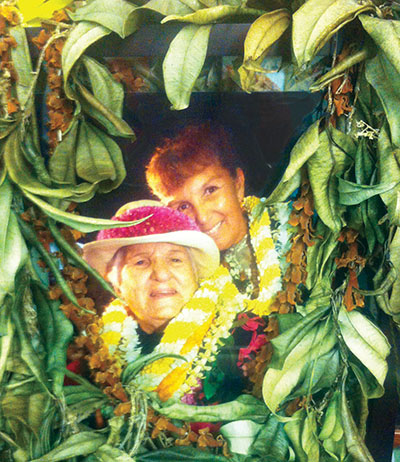
In 1979 the festival moved to the Edith Kanaka‘ole Tennis Stadium, where it has been held ever since. The next year television cameras arrived. Since 1981 the Merrie Monarch has been receiving uninterrupted live coverage on statewide television. And today it is streamed live over the internet.
“Nānā i ke kumu,” advises a famous Hawaiian proverb, “Pay attention to the source.” In hula this can bear the obvious meaning of “Watch what your kumu (teacher) does.” It also contains a more profound admonition not to lose sight of hula’s roots in the ancient protocols of Hawai‘i and Polynesia.
As the dancers and the kumu have carefully observed each other throughout the five decades of competitions, they have evolved together in a tightly woven tradition, learning from each other and reaching for higher and higher levels of excellence. This, in turn, has also significantly influenced the worldwide scope of hula teaching and performance, says Kumu Etua.
As part of their preparation for Merrie Monarch competition, kumu hula must now create fact sheets that explain the meaning and translates the ka‘i (entrance), the mele (song), the hula (dance) itself, and the ho‘i (exit).
“A lot of the kumu have told me how much they appreciate my mom forcing them to do this research because they themselves have learned a lot through this,” said Luana.
Kumu Etua agrees. “The research is something new. Before you just got it from your teachers. And it came in the family lineage. You could tell what family the dancers were from by the way they danced.”
The first winner of the solo competition, Miss Aloha Hula, was Aloha (Wong) Dalire, today a kumu whose three daughters each have won the same title. Many kumu pass on the leadership of their hālau to one of their children.
With heightened emphasis on excellence, the judging has to look at more and more detail, says Etua. “Now everything is fine-tuned,” he explains. “The lei, the regalia, the ‘ōlelo. In the beginning there were some groups with very high precision and some groups not so much. As time went on, they got better.”
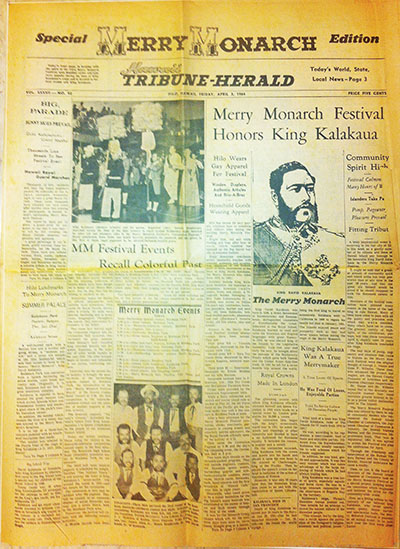
Each year, the kumu are challenged to get more and more creative, yet retain the authenticity of the dance and the culture.
As a young volunteer, Etua says he learned that the lowly position of floor sweeper at the auditorium had a benefit. “While sweeping, I heard chanting and I realized I could peek through a crack and watch the rehearsals. I never told anyone the details. I could see how the masters did it, such as Aunty Vicky Holt Takamine and Hau‘oli Hula Studio. I would tell myself, ‘Boy, if I ever become a teacher, my dancers will look like this.’ I really think Merrie Monarch was a big part of the renaissance of the culture and teaching of Hawaiian studies in school and college. In my time with Uncle, we were told how to do everything. We had to make everything because it was not available in stores. We had to weave our lauhala mats, make and dye our costumes, our implements, everything we used.” Nānā i ke kumu. Look to the source.
With all the success of the Merrie Monarch Festival, Aunty Dottie was adamant that it remain in Hilo with its roots on Hawai‘i Island, legendary home of the goddess Pele. Dottie kept admission prices low and resisted efforts to move the Merrie Monarch to a larger facility or a larger city.
“I won’t allow it,” affirms Luana. “This is a small, humble, hula event and we want to keep it that way—keep it humble and share our tradition of hula with the world.”
The festival invites hālau primarily from Hawai‘i, or those hālau on the continental U.S. whose kumu were trained and raised within a Hawai‘i hālau.
In a small, nondescript building next to the stadium, the office is staffed with all volunteers, recruited from family as well. Aunty Dottie’s other daughter, Lei Andrade, sits at the reception desk, and Luana is grooming her own daughter, Kathy Kawelu to someday take over the reigns of the festival, as her mother once groomed her. In addition to her sister, Lei, her brother, Bo Saiki, son Albert Kawelu Jr., her daughter Colleen Kawelu, and granddaughter Kawena Kawelu also help.
Nānā i ke kumu. Look to the source. The roots are strong, the lineage intact, the attitude humble and the pathway set for the next 50 years. ❖
For more information: MerrieMonarch.com
Contact writer Karen Valentine: karenvalentine808@gmail.com
